Whether the application is industrial, medical,
military or scientific, diagnosing a problem in your optical system can be confusing,
time-consuming and costly. Beam profiling can help.
There can be few frustrations greater than
finding that your laser-based optical system is not working as well as expected,
or that it is failing altogether. But a possible solution literally goes straight
to the source: Measuring the beam quality of the optical system could reveal that
the beam power is not spatially distributed as expected, or that the size of the
beam is not as expected.
Once the beam profile is corrected, the performance of most laser
processes can be improved: Industrial processing produces less scrap, medical procedures
are more precise, military devices can have greater effectiveness, and scientific
experiments can be more accurate.
“People working with lasers are trying to do something with
the light beam, either as the raw beam or, more commonly, modified with optics,”
said Gary Wagner, president of Ophir-Spiricon of Logan, Utah. “Whether it
is printing a label on a part, welding a precision joint or repairing a retina,
it is important to understand the nature of the laser beam and its performance.
“Laser beam profiling provides the tools to characterize
the laser and know precisely what the beam is doing at the point of the work, and
if the optics are having the desired effect.”
The problem is that lasers are like lightbulbs – their output
is constantly changing. The instantaneous or average power/energy, or the spatial
distribution of the power within the cross section of the laser beam, can change
over time.
Sebastian Krollmann, a marketing communications officer at Thorlabs,
advises that whenever the power density of the laser beam is important, analysis
of the beam profile should be considered.
“Beam profiling provides detailed information about the
quality of laser beams with respect to the spatial distribution of the optical power
density in a 2-D plane perpendicular to the beam,” he said.
Get in line
An inconsistent output beam can be problematic or even dangerous
in some laser applications. Welding calls for the power distribution to be evenly
spread across the beam in what is known as a flattop distribution. If the distribution
is higher in the center than on the sides (as in a Gaussian distribution), the laser
could be too hot in the center of the weld, causing piercing, and too cold on the
edges, making a poor weld.
“Without beam profiling, laser owners are not certain of
how the laser power is distributed across the beam. With a beam profiler, they can
set up and quickly check to make sure the power distribution is what they need for
consistent application. If not, any adjustments can be made before they start their
production,” Ophir-Spiricon’s Wagner said. “By doing this, they
can reduce their scrap, improve quality and decrease their time to get the job done.”
When it comes to medical applications, however, the collateral
damage caused by an unwanted beam could be much more serious. In lasik surgery,
for example, if the laser power changes from day to day or from month to month,
the depth of the cut will be shallower or deeper than the surgeon intends.
Jay Jeong, a product manager at Newport Corp. of Irvine, Calif.,
offers the perspective that beam profilers have done more than improve the performance
of individual optical systems; he asserts that the devices have been instrumental
in the growth of the photonics industry as a whole.
“I believe the broad applications of beam profiling methods
enabled lasers to be adopted, improved and fine-tuned in real-life applications,”
he said. “The applications that strongly impacted consumers early on, such
as laser welding (in automobile manufacturing, for instance) and machining (labeling),
readouts (bar-code readers) and medical applications, are the key contributors to
the growth of the optics and photonics industry.”
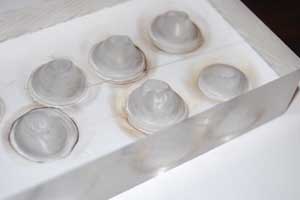
Historically, acrylic plastic is put in front of the beam to make
a 3-D representation of the profile. Caution: Burning acrylic plastic produces carcinogenic
fumes! Courtesy of Ophir-Spiricon.
Sizing up beam profilers
A beam’s size, shape, expected intensity distribution and
divergence can all be characterized by profilers, but selecting the right profiler
depends upon the task; the application determines the most important aspects of
the beam one wants to analyze, which may be the maximum intensity, homogeneity,
the beam’s special shape or a combination.
The camera-based beam profiler is one of the most common types.
Newport Corp.’s CCD-based beam profiler, for example, is its most popular
product. The camera-based systems capture the entire beam profile by using a CCD,
CMOS or infrared camera, which provides a real-time 2- and 3-D image of the beam.
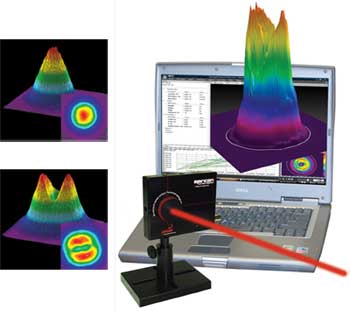
Camera-based systems capture the entire beam profile by using a CCD
or CMOS camera, which provides a real-time 2- and 3-D image of the beam. Images
courtesy of Ophir-Spiricon.
Although confined to the ultraviolet to very near infrared wavelength
range, camera-based profilers allow for near-real-time monitoring of the beam’s
alterations as the laser’s cavity mirrors are adjusted. Wagner explains that
this type of dynamic laser monitoring is particularly useful for applications such
as welding or cutting.
“It is well documented that the beam’s power distribution
changes during the first half-second or second in a multisecond application,”
he said. “Another example would be to monitor the focused spot position from
the nozzle opening. We know that the focused spot distance changes as power changes
or as the optics get dirty and worn. Using a beam profiler, the user can periodically
monitor focused spot position and adjust the machine’s setting to cope with
these dynamic process changes.”
Camera-based systems should be used when a true 2-D profile is
of importance, such as for analysis of non-Gaussian beams. They are also preferable
for pulsed sources. While the systems are flexible and intuitive, the downside is
that the camera pixels can saturate and become damaged from too much power.
For a more precise intensity measurement, use slit- or knife-edge-based
systems. They consist of a single photodetector with moving slits that construct
the beam profile based on direct measurements of focused and collimated beams.
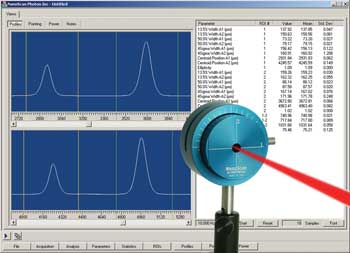
One large advantage in using a scanning slit profiler is that beams can be viewed directly with little or no power attenuation needed. Courtesy of Ophir-Spiricon.
Compared with camera-based profilers, scanning slits are not as
restricted by wavelength. They can be equipped with different detectors and so can
measure beams at any wavelength from the ultraviolet to the far-infrared (around
200 nm to beyond 100 μm).
Also, they can measure beams as small as 4 μm to as large
as 20 mm. One of the big advantages for scanning slits is that the laser can be
viewed many times without any power attenuation, which is useful for direct viewing
of the focused spot.
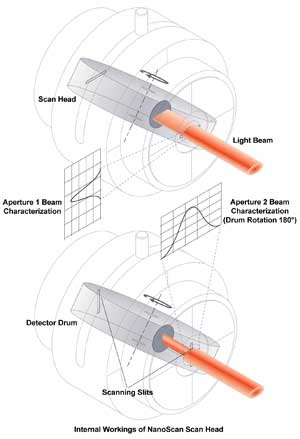
The scanning slit beam profiler moves a narrow slit in front of a photodetector through the beam under analysis. Courtesy of Ophir-Spiricon.
“The assumed beam profile departs from the theoretical shape;
therefore, the resultant calculations bear more errors,” said Newport’s
Jeong. “However, they can handle smaller beams or higher-power beams without
additional attenuation optics.”
But for beams that are high power, very small or rotationally
symmetric, slit-based profilers are called for.
Pyroelectric matrix arrays use pyroelectric cameras to operate
across the broadest wavelength range of any camera system for beam profiling. With
responses from 13 nm to 3 mm in wavelength, they are a good choice for the deep-ultraviolet,
mid-infrared and far-infrared applications. They have 100-µm pixel pitch, so for
getting the most accurate measurements, they are limited to beams above 1 mm in
size.
Goniometric radiometers are specially designed to make measurements
of highly divergent beams such as those of laser diodes, vertical-cavity surface-emitting
lasers, LEDs and bare fiber. Characterizing these types of beams allows for proper
coupling of the light to other devices, or helps design optical systems to modify
the beams for use in other applications.
Even though the goal of using a beam profiler is to characterize
the laser beam, Jeong says that the user first must have some knowledge of the laser
beam he is working with, such as its intensity, spot size, shape and wavelength,
along with other characteristics.
“Otherwise, the laser beam profiler can be saturated or
damaged, or produce unreliable data,” he said. “Therefore, it is important
to do some preliminary qualitative beam profile measurements by using laser sensor
cards or thermal papers, or even visual observations as well as quantitative optical
power measurements.”
The shape of the future
As computers become more powerful and software advances, interpretation
of measurements made by beam profilers is expected to improve.
The current trend includes more automation, integrated pass/fail
criteria for manufacturing, and video capturing. Future software releases will include
functions and data acquisition capabilities that are even more sophisticated.
“The latest advances are related to the upgraded software
interfaces to meet the needs of 64-bit operating systems,” Wagner said. “Some
of these have new Microsoft ribbon bar structures that make it easier to customize
and use to position windows and results in the way the customer sees fit.”
Ophir-Spiricon recently introduced an enterprise version of its
BeamGage camera-based software. A Gigabit Ethernet camera can be remotely run from
a BeamGage-enabled computer somewhere else on an intranet.
“We see this as a fantastic advantage for labs and universities
that want to have either (a) many cameras run from a single version of BeamGage,
or (b) a camera shared by many users running multiple versions of BeamGage from
anywhere in the world,” Wagner said.
In terms of hardware advances, many attenuation schemes are being
designed to meet customers’ needs with ever-increasing power and energy. This
is continually a challenge as powers have increased to greater than 50 kW for some
of the new fiber lasers.
According to Thorlabs’ Krollmann, an important challenge
when it comes to developing camera profilers is improving the accuracy of the baseline
in relation to background noise.
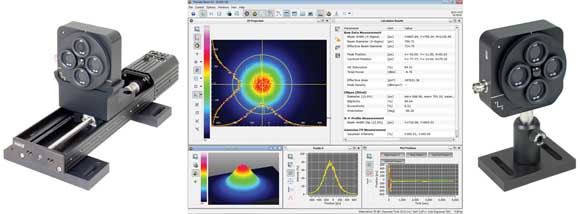
For Thorlabs’ beam profilers, optional extension kits for automated M2 beam quality analysis are available. The software package can be downloaded for free from the company’s website. Shown here is the BC100 series camera profiler. Images courtesy of Thorlabs.
The accuracy of the baseline plays a crucial role when using the
profiler for M2 measurements to determine beam quality through analysis of multiple
profiles along the beam path, he said.
Advances in camera technology are expected to reduce the cost
of beam profilers. For example, thanks to heavy use in consumer products, CMOS cameras
are improving quickly and are increasingly being adopted in profiling systems.
Newport’s Jeong believes that beam profilers will take advantage
of the slightly more slowly evolving, but nevertheless exciting, advances that are
taking place in scientific camera technology.
“These include larger chip size, improved signal-to-noise
ratio or dynamic ranges, higher frame rates and broader wavelength ranges,” he said.